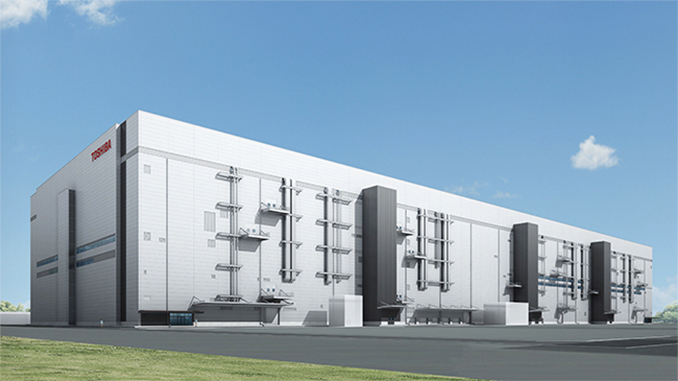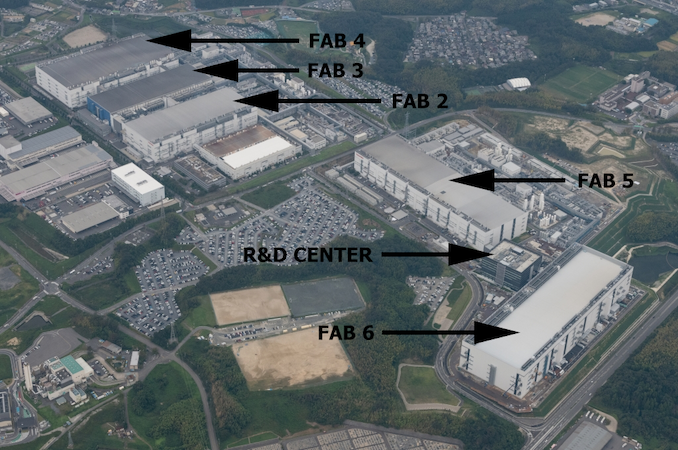Toshiba & WD NAND Production Hit By Power Outage: 6 Exabytes Lost
by Anton Shilov on June 28, 2019 12:15 PM EST
Toshiba Memory and Western Digital on Friday disclosed that an unexpected power outage in the Yokkaichi province in Japan on June 15 affected the manufacturing facilities that are jointly operated. Right now, production facilities are partially halted and they are expected to resume operations only by mid-July.
Western Digital says that the 13-minute power outage impacted wafers that were processed, the facilities, and production equipment. The company indicates that the incident will reduce its NAND flash wafer supply in Q3 by approximately 6 EB (exabytes), which is believed to be about a half of the company’s quarterly supply of NAND. Toshiba does not disclose the impact the outage will have on its NAND wafer supply in the coming months, but confirms that the fabs are partially suspended at the moment. Keeping in mind that Toshiba generally uses more capacity of the fabs than WD, the impact on its supply could be significantly higher than 6 EB with some estimating that it could be as high as ~9 EB.
Both companies are assessing the damage at the moment, so the financial harm of the incident is unclear. Not even counting potential damage to production tools and other equipment used at the fabs, 6 EB of NAND cost a lot of money. Furthermore, analysts from TrendForce believe that a consequence of the outage will be some loss of confidence from clients of both companies, which will have a financial impact as well.
The Yokkaichi Operations campus jointly owned and run by Toshiba and Western Digital produces about 35% of the global NAND output in terms of revenue, according to TrendForce. At present, the manufacturing base has five production facilities (Fab 2, Fab 3, Fab 4, Fab 5, and Fab 6) as well as an R&D center, all of which were affected by the outage. Three fabs within the campus produce 3D NAND flash, whereas another two are used to make special-purpose types of memory.
Considering the gargantuan size of the Yokkaichi Operations, disruptions of its supply will inevitably have an effect on 2D NAND and 3D NAND spot prices in the short-term future. Nonetheless, since contract prices have already been set for Q3 (and possibly Q4), they are not going to change. Meanwhile, it remains to be seen whether large customers will have to go shopping in Q3 or Q4 and affect prices on the spot markets further.
Considering that the Yokkaichi Operations produces at least 1/3 of the global NAND flash output (let’s assume that dollar share more or less corresponds to bit share) and half of its production for the quarter was lost because of the incident, this means that the industry will miss approximately 1/6 (or 16.5%) of the global NAND supply in Q3. Whether or not this will create a deficit on the market that will cause significant price hikes depends on multiple factors and is something that remains to be seen.
Related Reading
- Toshiba Memory and Western Digital Open Fab 6 and New Memory R&D Center
- Toshiba Memory & Western Digital Finalize Fab K1 Investment Agreement
- Toshiba Begins to Construct New BiCS 3D NAND Fab in Iwate Prefecture
- Toshiba Memory to Build New Fab to Produce BiCS 3D NAND
- Toshiba Finalizes Plans for New 3D NAND Fab: Coming Online in 2019
- Toshiba to Build New Fab to Produce BiCS NAND Flash
Sources: Western Digital, Reuters, TrendForce, Blocks & Files












148 Comments
View All Comments
imaheadcase - Friday, June 28, 2019 - link
You underestimate the amount of power a place like this needs. Battery backup is prob just for certain critical applications, and generators can't sustain the power output.voicequal - Friday, June 28, 2019 - link
Battery backup (or mechanical energy from a flywheel) is only there to hold the load until generators spin up. That is why batteries may only last a few minutes at most. There's almost no reason to have batteries if you don't have generators. The disaster happens when the generators don't start.Threska - Friday, June 28, 2019 - link
Not really. But what one needs is the same thing a city would need. A power PLANT. Land being what it is in Japan space may be tight for something like that.http://energyskeptic.com/2014/interdependent-chip-...
And note he says "expensive" not impossible.
Also https://www.researchgate.net/publication/237511031...
Is 2.18 kW/m2
rahvin - Friday, June 28, 2019 - link
Regardless of power requirements they not only could but should have had in place emergency power. IMO it's fiscal negligence to not have full backup power capability that could either keep the factory going through an outage or at the very least allowed a controlled shutdown to minimize wafer loss.You act as if Diesel generation systems are impossible to build and having emergency plans for something like this is impossible. There are entire countries that run on Diesel generators and some of those countries are not small. For about one acre of ground they could have had a cluster of diesel generators that could have supplied emergency power in the gigawatt range and it's literally trivial to purchase diesel delivery contracts that would have kept those generators running until the mains came back on upwards of months if necessary (though at that kind of timeframe the costs would get exorbitant).
Sure it would have cost several tens of millions of dollars for the generators and ongoing maintenance costs of several hundered thousand a year to keep them at peak form and working but frankly if I was invested in this company I'd be furious that management had been this negligent. They just lost a whole quarters revenue (and with repair and scrapping of the damaged stuff it's probably closer to 2Q's worth of revenue) due to fiscal negligence by management.
Any type of factory that is that dependent on power is going to have backup power systems in place for both short outages and much longer mains failures. That these fabs didn't is just unbelievable, what if someone knocked a power pole over down the road in a car accident? The exact same thing would have happened and that's a very common accident. They literally had no protection for an outage of more than a few minutes and that's just criminal.
jordanclock - Friday, June 28, 2019 - link
That's some impressive armchair engineering. Why didn't Toshiba and WD consult you when they were building their multi billion dollar campus when you clearly know better than all of the engineers they hired?!Threska - Saturday, June 29, 2019 - link
Sometimes decisions aren't a matter of engineering, but of economics. Clearly somewhere in Japan someone engineering a system that could supply all these plants and others. That takes care of the smart-alec "why didn't they consult you". They didn't need to when someone else already did all the work. What they didn't do is basically duplicate that system and the reason for that is simple economics. Just because it's called "semiconductor manufacturing" doesn't mean "bottom-line" is ignored. And in that vein "cheap electronics" is part of that. So let's ask ourselves the most important question. Are we willing to spend more for our electronics so plants like this can survive power outages for a reasonable amount of time?rahvin - Monday, July 1, 2019 - link
The companies involved likely believed, at the time the plants were built, that because Japanese power was primarily provided through nuclear that the chances of a sustained outage were near impossible. The entire equation on that changed with the fukushima disaster and they should have adjusted.Economics no doubt plays into the equation but you know why this type of disaster doesn't happen very often? Because all the other fabs have backup power systems in place. Anyone this dependent on power has backup systems and contracts in place, hell even my office building has such systems.
whyaname - Friday, July 5, 2019 - link
I think several people pointed out that the amount of power needed is in the area of 60MW.Meaning a feasible redundancy strategy like a back up grid or so would have solved the issue.
zodiacfml - Saturday, June 29, 2019 - link
sadly but trueDyneCorp - Saturday, June 29, 2019 - link
Man you people are nuts.